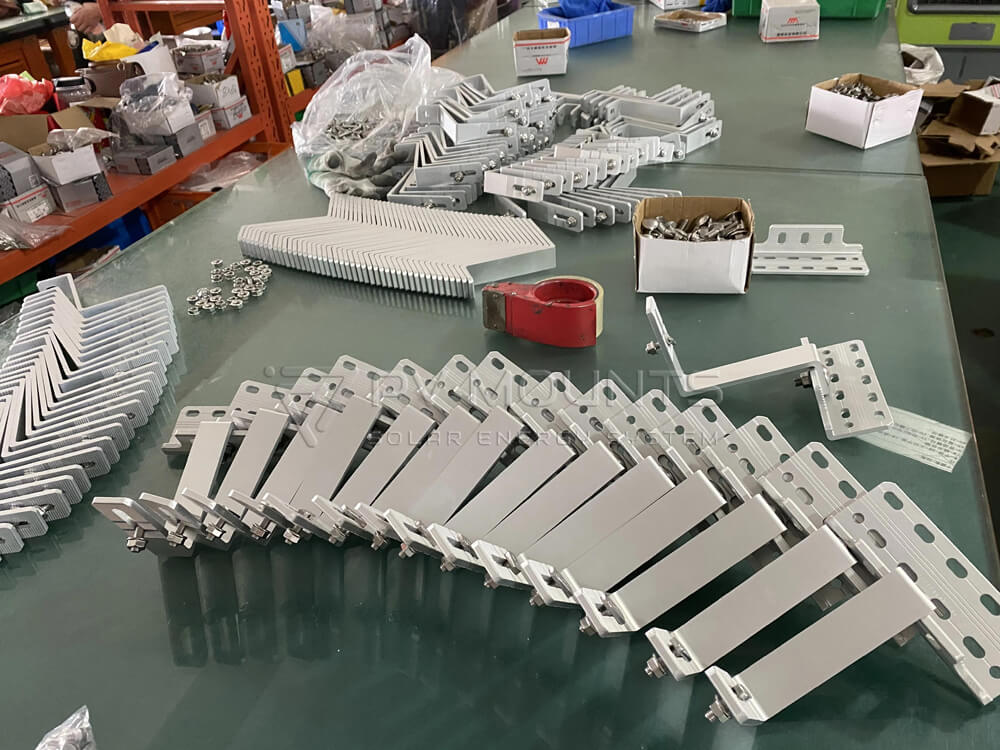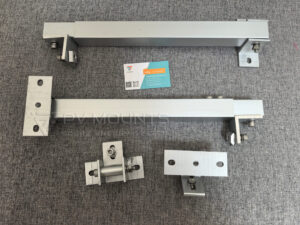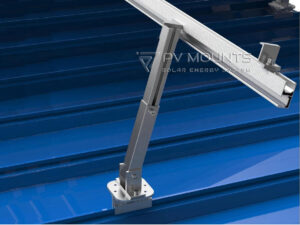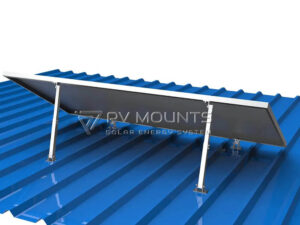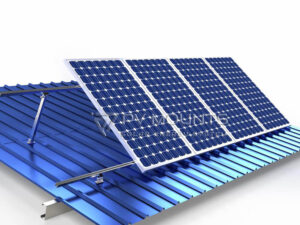The transition towards renewable energy is essential in today’s environmentally conscious world, and solar power stands at the forefront of this movement. A key component in the successful installation of solar panels, especially on residential roofs, is the robust and reliable mounting system. Tile roof hooks, specifically designed for tile roofs, play a pivotal role in these systems. This article provides a comprehensive guide of the manufacturing processes, design considerations, and practical applications of tile hooks for solar mounting, highlighting their importance in enhancing solar panel efficiency and durability.
Understanding Tile Roof Hook
What are Roof Tile Hooks?
Tile hooks are precision-engineered brackets that are essential for installing solar panels on tiled roofs. These hooks are adeptly crafted to fit securely between the roof tiles, ensuring that the panels are mounted without damaging the integrity of the tiles themselves. Their design allows for a seamless integration with the roof, maintaining the aesthetic appeal while providing a sturdy base for the solar panels.
Types of Tile Roof Hooks
The diversity in roof tiles necessitates a variety of tile hook designs. There are several types of tile hooks, each tailored to accommodate different tile materials and shapes—ranging from flat to Spanish tiles. This variety ensures that regardless of the roof type, there is a tile hook capable of providing optimal support. Manufacturers often categorize these hooks based on their compatibility with specific tile types and the load they can bear, which is crucial for areas prone to extreme weather.
Material Specifications
The materials used in the production of tile hooks are selected based on their strength, durability, and resistance to environmental factors such as UV exposure and corrosion. Stainless steel and aluminum are the most commonly used materials due to their robust nature and longevity. These materials are treated to withstand harsh conditions, ensuring that the tile hooks not only last as long as the solar panels but also maintain their structural integrity under the stress of load and weather.
Design and Engineering
Design Considerations
Designing tile roof hooks involves a detailed understanding of structural dynamics as well as aesthetic considerations. Engineers must consider the weight distribution, roof slope, and the type of tiles to ensure the hooks do not lead to any structural damage or leaks. The design process also includes the development of prototypes and the use of CAD software to simulate stress points and potential failure modes, ensuring the final product is both efficient and safe.
Structural Integrity and Load Management
The structural integrity of tile roof hooks is paramount. These components are designed to distribute the load of the solar panels evenly across the roof structure. This distribution is critical to avoid concentrated stress points that could damage the tiles or the roof structure itself. Advanced engineering practices and stress analysis are used to optimize the design, enhancing the overall stability of the solar mounting system.
Manufacturing Process
Raw Materials
The choice of raw materials is a crucial first step in the manufacturing process of tile roof hooks. High-grade stainless steel and aluminum are predominantly used for their excellent strength-to-weight ratios and corrosion resistance. The selection of suppliers is rigorous, ensuring that the raw materials conform to international standards for quality and sustainability.
Fabrication Techniques
Manufacturing tile hooks involves precision fabrication techniques to meet the strict tolerances required for effective functionality. Techniques such as laser cutting and CNC machining are employed to achieve the intricate designs needed for specific tile types. These processes are automated to maintain consistency and quality across large production runs.
Quality Control Measures
Quality control is integral to the manufacturing process. Each batch of tile hooks undergoes a series of tests, including load testing and environmental exposure tests, to ensure they meet the required specifications. This rigorous testing guarantees that every tile hook delivered to the market performs reliably under the conditions they will face in real-world applications.
Cost Analysis
Cost Factors
The cost of tile roof hooks for solar mounting can vary significantly based on several factors, including the material used, the complexity of the design, and the scale of the solar installation. Stainless steel hooks, while more expensive, offer greater durability and strength, potentially reducing long-term maintenance costs. The design complexity can also impact cost; more intricate designs that accommodate unique roof tiles or enhanced load-bearing capacities may require more expensive manufacturing processes.
Economic Benefits
Investing in high-quality tile hooks can provide substantial economic benefits over the lifespan of a solar energy system. Firstly, the robust construction and careful installation of these hooks minimize the risk of damage to both the solar panels and the roof, reducing repair and replacement costs. Additionally, a secure and stable solar panel installation increases the system’s efficiency and longevity, leading to greater energy production and savings on electricity bills. These economic benefits make the initial investment in premium tile hooks worthwhile, especially considering the potential increase in property value that a reliable and efficient solar energy system can bring.
Durability and Maintenance
Lifespan and Durability
Tile roof hooks are designed to last as long as the solar panels themselves, typically around 25 to 30 years. Made from materials resistant to rust, corrosion, and UV degradation, these hooks are built to withstand the elements without weakening or becoming brittle. The durability of tile roof hooks is critical as they must continuously bear the weight of the solar panels and withstand dynamic loads such as wind uplift and thermal expansion of the roof materials throughout their lifespan.
Maintenance Requirements
Maintenance of tile roof hooks is generally minimal, primarily involving periodic inspections to ensure that all components remain tight and are not showing signs of wear or corrosion. These inspections are typically part of a broader check-up of the solar panel system, including cleaning the panels and checking electrical connections. Regular maintenance ensures that the system continues to operate at optimal efficiency and prevents minor issues from developing into major problems.
In the following sections, we will delve into the environmental impact of manufacturing tile hooks, explore recent innovations in their design, and discuss the regulatory standards governing their use. These aspects highlight the ongoing developments and the commitment to sustainability in the solar industry.
Environmental Impact
Eco-Friendly Materials
In the manufacturing of tile roof hooks, there is a significant focus on selecting materials that not only provide strength and durability but also are environmentally friendly. Stainless steel and aluminum, the primary materials used, are both highly recyclable, reducing the environmental impact associated with the production of new materials. Manufacturers often prioritize suppliers who use recycled materials in their production processes, further minimizing the ecological footprint of their products.
Recycling and Waste Management
At the end of their life cycle, tile hooks are designed to be fully recyclable, ensuring that they do not contribute to landfill waste. The recycling process involves melting down the metal components to create raw materials for new products, which significantly reduces the need for virgin material extraction and the overall energy consumption in manufacturing. Effective waste management strategies are implemented throughout the manufacturing process to minimize off-cuts and scrap, with any waste metal being segregated and sent to recycling facilities.
Innovations in Roof Tile Hooks Design
Recent Technological Advancements
The design and manufacturing of tile hooks have seen substantial technological advancements in recent years. Innovations include the integration of adjustable and self-aligning features that facilitate faster and more accurate installation, which can significantly reduce labor costs and time on site. Additionally, some newer models incorporate smart technology that allows for real-time monitoring of load and stress, providing alerts for maintenance needs and ensuring long-term stability and safety.
Future Trends in Tile Hook Technology
Looking forward, the tile roof hook technology is set to become even more aligned with sustainable practices. Innovations may include the use of biodegradable materials or the integration of energy-efficient processes that reduce the carbon footprint during manufacturing. Furthermore, as solar panel technology evolves, tile hooks are likely to become lighter, stronger, and more adaptable to a variety of mounting situations, enhancing their applicability and efficiency in solar installations.
Regulations and Standards
Industry Standards
Tile roof hooks are subject to a variety of industry standards that ensure they are safe and effective for use in solar installations. These standards cover aspects such as load-bearing capacity, weather resistance, and longevity. Compliance with these standards is crucial, as it assures both installers and homeowners that the product will perform reliably under expected conditions. Regular updates to these standards reflect ongoing research and technological advancements, maintaining a high level of safety and performance in the industry.
Compliance and Safety
Manufacturers of tile roof hooks must adhere to strict compliance protocols to meet both national and international safety standards. This compliance is verified through rigorous testing, including mechanical stress tests and weather simulation, to ensure that the hooks can withstand extreme conditions without failure. Safety is paramount, not only to protect the investment made in solar systems but also to ensure the well-being of the occupants of the buildings on which they are installed.
Conclusion
The manufacturing of tile roof ooks for solar mounting is a crucial component in the broader adoption of solar energy, a key player in the transition to renewable energy sources. Through careful design, rigorous testing, and adherence to strict industry standards, these small but mighty components ensure the safety, efficiency, and durability of solar panel installations. As the solar industry continues to evolve, so too will the technologies that support it, including tile hooks. Their ongoing development is essential not only to the solar sector but also to achieving broader environmental goals and moving towards a more sustainable and energy-independent future.


